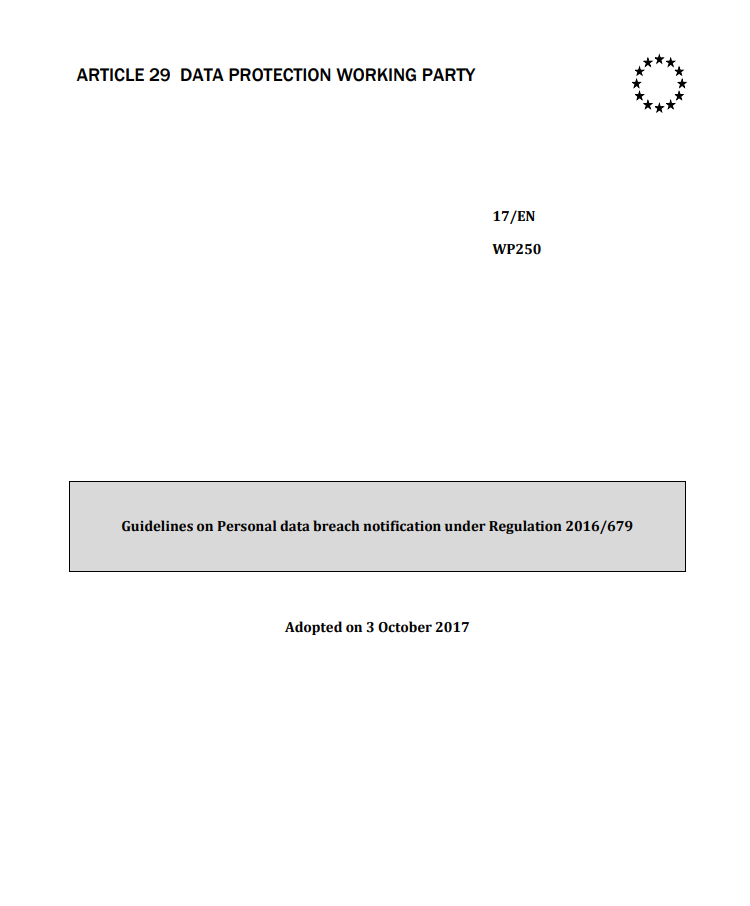Guidelines on Personal data breach notification under Regulation 2016/679
Adopted on 3 October 2017
INTRODUCTION
The General Data Protection Regulation (the GDPR) introduces the requirement for a personal data breach (henceforth “breach”) to be notified to the competent national supervisory authority and, in certain cases, communicate the breach to the individuals whose personal data have been affected by the breach.
Obligations to notify in cases of breaches presently exist for certain organisations, such as providers of publicly-available electronic communications services (as specified in Directive 2009/136/EC and Regulation (EU) No 611/2013)
. There are also some EU Member States that already have their own national breach notification obligation. This may include the obligation to notify breaches involving categories of controllers in addition to providers of publicly available electronic communication services (for example in Germany and Italy), or an obligation to report all breaches involving personal data (such as in the Netherlands). Other Member States may have relevant Codes of Practice (for
example, in Ireland). Whilst a number of EU data protection authorities currently encourage controllers to report breaches, the Data Protection Directive 95/46/EC, which the GDPR replaces, does not contain a specific breach notification obligation and therefore such a requirement will be new for many organisations. The GDPR now makes notification mandatory for all controllers unless a breach is unlikely to result in a risk to the rights and freedoms of individuals. Processors also have an important role to play and they must notify any breach to their controller.
The Article 29 Working Party (WP29) considers that the new notification requirement has a number of benefits. When notifying to the supervisory authority, controllers can obtain advice on whether the affected individuals need to be informed. Indeed, the supervisory authority may order the controller to inform those individuals about the breach. Communicating a breach to individuals allows the controller to provide information on the risks presented as a result of the breach and the steps those individuals can take to protect themselves from its potential consequences. The focus of any breach response plan should be on protecting individuals and their personal data. Consequently, breach notification should be seen as a tool enhancing compliance in relation to the protection of personal data. At the same time, it should be noted that failure to report a breach to either an individual or a supervisory authority may mean that under Article 83 a possible sanction is applicable to the controller.
Controllers and processors are therefore encouraged to plan in advance and put in place processes to be able to detect and promptly contain a breach, to assess the risk to individuals, and then to determine whether it is necessary to notify the competent supervisory authority, and to communicate the breach to the individuals concerned when necessary. Notification to the supervisory authority should form a part of that incident response plan.
The GDPR contains provisions on when a breach needs to be notified, and to whom, as well as what information should be provided as part of the notification. Information required for the notification can be provided in phases, but in any event controllers should act on any breach in a timely manner.
In its Opinion 03/2014 on personal data breach notification, WP29 provided guidance to controllers in order to help them to decide whether to notify data subjects in case of a breach. The opinion considered the obligation of providers of electronic communications regarding Directive 2002/58/EC and provided examples from multiple sectors, in the context of the then draft GDPR, and presented good practices for all controllers.
The current Guidelines explain the mandatory breach notification and communication requirements of the GDPR and some of the steps controllers and processors can take to meet these new obligations. They also give examples of various types of breaches and who would need to be notified in different scenarios.
Διαβάστε ολόκληρο το έντυπο:
